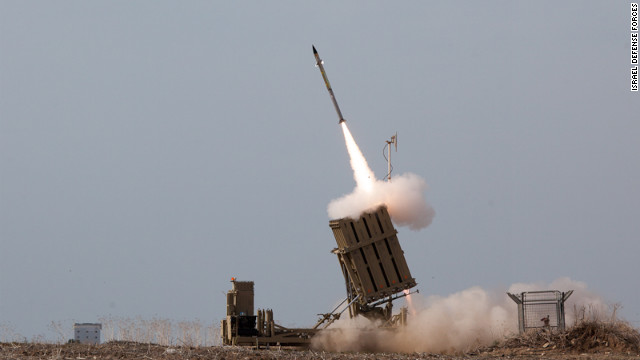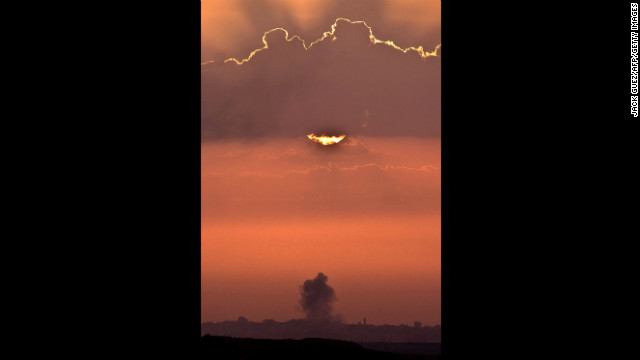November 18, 2012

An Iron Dome system in Ashdod, Israel, launches to intercept a rocket fired from Gaza on Saturday.
STORY HIGHLIGHTS
- Israel's missile system targets rockets fired from Gaza
- In 2011, Israeli military said Iron Dome had 70% success rate, IHS Jane's says
- The system is highly mobile and can be set up in hours
- The United States has allocated a total of $275 million for Iron Dome
Iron Dome is being credited with protecting Tel Aviv and other Israeli cities by blocking some of the rockets fired from Gaza.
Over the past three days,
737 rockets from Gaza were fired upon Israel: 492 landed, but 245 were
intercepted by the system, Israel Defense Forces said Saturday.
What is it?
The name Iron Dome evokes
an image of a protective bubble over a city. In practice, Iron Dome is a
defense against short-range rockets and mortar shells: the system
targets incoming rockets and fires an interceptor missile to destroy
them midair.
 Photos: Violence flares between Palestinians, Israelis
Photos: Violence flares between Palestinians, Israelis
Each battery has a
firing-control radar to identify targets and a portable missile
launcher. The system is easily transportable, with just a few hours
needed to relocate and set up.
The missile is highly
maneuverable. It is three meters, or almost 10 feet, long; has a
diameter of about six inches; and weighs 90 kilograms, or 198 pounds,
according to the security analysis group IHS Jane's.
The warhead is believed
to carry 11 kilograms, or 24 pounds, of high explosives, IHS Jane's
said. Its range is from 4 kilometers to 70 kilometers -- or 2.5 miles to
43 miles.
What are the origins of Iron Dome?
Israel began developing the ground-based system in 2007.
After a series of test
flights in 2008 and 2009, the first deployment of a battery occurred in
southern Israel in 2011, according to IHS Jane's and the IDF. The Israel
Air Force reported an interception success rate of 70% in 2011, IHS
Jane's said.
Israel credits
"breakthrough technology" and the system's radar. Iron Dome confronts
multiple threats simultaneously, in all weather conditions, the Israeli
military said.
"The radar detects a
rocket launch and passes information regarding its path to the control
center, which calculates the predicted point of impact," the IDF said.
"If this location justifies an interception, a missile is fired to
intercept the rocket. The payload of the interceptor missile explodes
near the rocket, in a place that is not expected to cause injuries."
Each Iron Dome battery costs $50 million, IHS Jane's said. A missile costs at least $62,000, Israeli officials said.
Is the United States involved in Iron Dome?
Yes.
The initial development
was solely by Israel's defense technology company Rafael, but the system
has since been heavily sponsored by the United States.
In May 2010, the U.S.
House approved a plan to allocate $205 million for Iron Dome. In July,
President Barack Obama announced $70 million in U.S. funding.
"This is a program that
has been critical in terms of providing security and safety for Israeli
families," Obama said of the system. "It is a program that has been
tested and has prevented missile strikes inside of Israel."
How important is Iron Dome?
Israel has deployed five
Iron Dome batteries, but in March, a defense ministry official told CNN
that Israel would need up to 13 batteries to cover all its borders.
Israel plans to deploy a total of nine batteries by 2013, Israeli media
reported.
The system is considered a game changer, Israeli officials said earlier this year.
"Eliminating the ability
to hit strategic targets may lead Hamas to rethink the efficiency of
acquiring the rockets it has used in the past," former Israeli
ambassador to the United States Dore Gold said in March.
Prime Minister Benjamin
Netanyahu said that same month: "The Iron Dome system has proven itself
very well and we will, of course, see to its expansion in the months and
years ahead."
Other countries have
expressed interest buying the system, including the United States, South
Korea and several NATO countries in Europe with military forces in
Afghanistan, the Jerusalem Post reported in March.
No comments:
Post a Comment